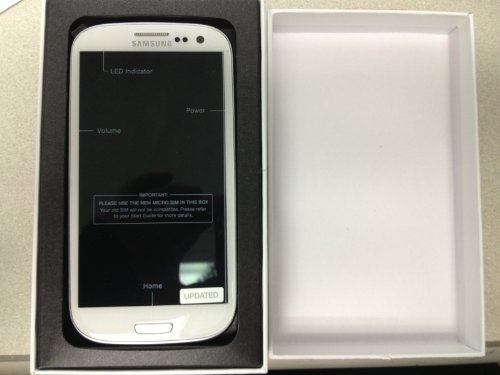phone mobile&Accessories See Samsung Galaxy S III T999 16GB Unlocked GSM Phone with Android 4.0 OS, Super AMOLED Touchscreen, 8MP Camera, GPS, Wi-Fi, Bluetooth and microSD Slot - Marble White Details
Product Description
This Samsung Galaxy S III cell phone delivers a suite of Samsung interactive features and fast, powerful processing capabilities to the T-Mobile service network. Leveraging 2 GB of internal RAM in tandem with 16 GB of onboard memory, this Samsung Galaxy has the power it needs to drive impressive technology such as S-Voice, the Samsung virtual personal assistant; S Beam, a laser-based method for directly sharing content with another Samsung Galaxy phone; and AllShare Play, which allows users to display their phone media content on an HDTV or computer. This Samsung Galaxy S III cell phone also comes standard with a rear-mounted 8 MP camera, and a front-facing video-enabled camera for conference calls. Photos snapped on this camera can be automatically shared with up to five friends thanks to the Share Shot feature on this smartphone. This Samsung Galaxy also can understand a range of human gestures and initiate commands and actions at the sweep of a hand or simply by a user placing this smartphone next to his or her ear, making it a powerful and intelligent communication tool.
- FOR T-MOBILE
- WITH BOX AND ALL MANUALS
- MANUFACTURED REFURBISHED
More About Samsung Galaxy S III T999 16GB Unlocked GSM Phone with Android 4.0 OS, Super AMOLED Touchscreen, 8MP Camera, GPS, Wi-Fi, Bluetooth and microSD Slot - Marble White
Images of old cell phones in one the 90s seem to be a surefire way to spark laughter-they appear to be big, cumbersome, and look ridiculously outdated compared to the small gizmos we have today. So it ought to be surprising to find out that the very first conception of crude, mobile phones actually dates all the way back to 1947. Researchers tried to evolve the technology utilised in walkie talkies. They realized that by utilizing small cells Instead of relying on single frequencies they can often reuse the same frequencies, and thereby dramatically raise the traffic capacity. In other words, the first kernel of invention was present, but unfortunately its potential was halted.The FCC (the enterprise in the U.S Which regulates anything to do along with other broadcasting or sending Tv or radio waves) blocked AT & T's request to allocate a massive number of radio spectrum frequencies. This will have provided the groundwork for widespread cell phone use and would have given AT & T incentive to further create the technology. Under the strict FCC regulations of those time, airwaves only allowed for twenty-three phone conversations to adopt place at any given time. This mentality was symbolic of the limited Studying of cell phone technology's potential. In hindsight it looks just like a boneheaded decision, however it ought to be remembered that this was 1947, therefore the FCC really should be at least partially excused for not Understanding the full implications of modern communications technology. still though, the idea lay buried for decades.
It wasn't until 1973 when Dr. Martin Cooper, former general manager of these Systems division at Motorola, was credited with Creating the very first ever call on a portable cell phone-a privilege he enjoyed as its chief creator. Ironically, the initial call was designed to the head of research labs at Bell, their chief competitor. perhaps this was in reality fitting given that Bell was responsible for inventing the crude mobile phone that was made to be employed in police cars at the 40s. Four years later, Bell created a prototype that was utilized on trial in Chicago by as much as two thousand people. Two years after that, in a completely unrelated venture, a separate operation was undertaken in Tokyo. There was considerable international buzz about the new technology since it went from being something existing only in science fiction to something that would appear imminently.
In 1981 Motorola joined with American Radio Telephone to start a second U.S. cellular telephone method test in Washington and Buffalo. The movement was gaining momentum, and by 1982 the FCC finally authorized commercial cellular services towards the United States. Ameritech made the first American commercial analog cellular service available in Chicago. Still, the technology was expensive and it was far from being as accessible as phones seem to be today. But by 1987 cellular phone subscribers exceeded one million and airways were crowded.
The 90s brought on a new wave of cell phone technology that ushered at the modern era where one belongs into the average person. Yes, those massive 90s clunkers look old, but who'd have believed that the cell phone was in reality conceived of so numerous decades ago?
Samsung Galaxy S III T999 16GB Unlocked GSM Phone with Android 4.0 OS, Super AMOLED Touchscreen, 8MP Camera, GPS, Wi-Fi, Bluetooth and microSD Slot - Marble White Reviews
Samsung Galaxy S III T999 16GB Unlocked GSM Phone with Android 4.0 OS, Super AMOLED Touchscreen, 8MP Camera, GPS, Wi-Fi, Bluetooth and microSD Slot - Marble White:phone mobile&Accessories



No comments:
Post a Comment